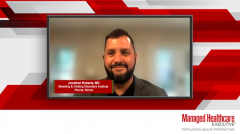Treatment of Hemophilia A: Evolution, Standard of Care, and Challenges
Hematologist Jonathan Roberts, MD, discusses the history and challenges of hemophilia A treatment.
Jonathan Roberts, M.D.: Treatment for hemophilia A over time has really evolved. A few decades ago, the focus was on obtaining a safe and pure recombinant factor product versus plasma-derived factor products where the half-life of these therapeutics is approximately eight to 12 hours in general, maybe even shorter in the pediatric population. And since then, in the past decade or more, we’ve seen an explosion in extended half-life therapies and nonfactor therapies for prophylactic management. With many more on the horizon, some newer products have been licensed and also gene therapy for individuals with hemophilia A. The challenge now as a clinician specializing in the field of coagulation, hemostasis, and taking care of these rare bleeding disorders is what type of therapy best fits your patient’s individual needs.
Factor 8 replacement has been the gold standard of hemophilia management and prophylactic therapy. Currently, on the market, there is one nonfactor factor 8 mimetic that’s a monoclonal bispecific antibody that’s also approved for prophylactic therapy. But still, the gold standard remains factor 8 therapy. And it depends on what your patient’s individual needs are as to what therapy is appropriate for them. The biggest difference with the current prophylactic therapies is, the bispecific antibody is subcutaneous. So especially now in patients who have difficult venous access or, young children that may otherwise require mediport placement. Now they’re able to have weekly subcutaneous prophylactic therapy. Now that being said, those patients that may be on that or any particular nonfactor therapy still would require factor 8 replacement if they had some sort of bleeding event or trauma breakthrough bleeding event. There are also, as I mentioned, other factor 8 therapies that have extended half-life capabilities that are all intravenously administered. So maybe for adults with hemophilia that don’t have intravenous access problems, the intravenous factor 8 therapies are very widely used for prophylaxis for hemophilia A.
I think the biggest challenges faced when treating hemophilia A are in determining what therapeutic regimen the patient will be most adherent to. So patient adherence is universally not unique just to hemophilia A but all fields in health care. But really trying to find out what particular barriers may exist in a patient’s life, whether they be problems with if they’re on intravenous therapy, being able to administer that at home, having technical skills to do that, or if it’s a child, the support system with parents or guardians that can actually safely administer their prophylactic therapy and then really trying to get to what the patient goals are. …[For] a more active patient, they’re going to need potentially more frequent therapy or more aggressive therapy, require more factor doses or finally regulating their nonfactor therapy. Maybe they’ll need additional factor in addition to their nonfactor prophylactic therapy that they’re on so that they can safely participate in the activities that they want to do. So really, it’s gone from this paradigm shift of, in the old days we were really just looking to maybe infuse with clotting factor concentrate a few days per week to try and prevent bleeds. Breakthrough bleeds would still happen. We tolerated it. And now really the paradigm shift is to focus on a life without bleeds for all individuals living with these disorders. So really being able to monitor factor levels and have a targeted pharmacokinetics of your individual patient - whatever therapy they’re on - is really useful in trying to then have your patient be adherent to therapy as possible.
Transcript edited for clarity.
Newsletter
Get the latest industry news, event updates, and more from Managed healthcare Executive.





















































